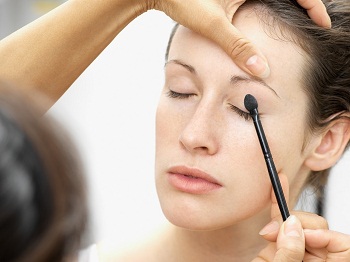What should I avoid when I am buying makeup or other personal care items?
These are the top 12 ingredients to avoid in your cosmetics. There is a link at the bottom to companies who pledge to avoid these chemicals.
 1. Antibacterials
1. Antibacterials
Overuse of antibacterials can prevent them from effectively fighting disease-causing germs like E. coli and Salmonella enterica. Triclosan, widely used in soaps, toothpastes and deodorants, has been detected in breast milk, and one recent study found that it interferes with testosterone activity in cells. Numerous studies have found that washing with regular soap and warm water is just as effective at killing germs.
2. Coal Tar
Coal tar is a known human carcinogen used as an active ingredient in dandruff shampoos and anti-itch creams. Coal-tar-based dyes such as FD&C Blue 1, used in toothpastes, and FD&C Green 3, used in mouthwash, have been found to be carcinogenic in animal studies when injected under skin.
3. Diethanolamine (DEA)
DEA is a possible hormone disruptor, has shown limited evidence of carcinogenicity and depletes the body of chlorine needed for fetal brain development. DEA can also show up as a contaminant in products containing related chemicals, such as cocamide DEA.
4. 1,4-Dioxane
1,4-Dioxane is a known animal carcinogen and a possible human carcinogen that can appear as a contaminant in products containing sodium laureth sulfate and ingredients that include the terms “PEG,” “-xynol,” “ceteareth,” “oleth” and most other ethoxylated “eth” ingredients. The FDA monitors products for the contaminant but has not yet recommended an exposure limit. Manufacturers can remove dioxane through a process called vacuum stripping, but a small amount usually remains. A 2007 survey by the Campaign for Safe Cosmetics found that most children’s bath products contain 10 parts per million or less, but an earlier 2001 survey by the FDA found levels in excess of 85 parts per million.
5. Formaldehyde
Formaldehyde has a long list of adverse health effects, including immune-system toxicity, respiratory irritation and cancer in humans. Yet it still turns up in baby bath soap, nail polish, eyelash adhesive and hair dyes as a contaminant or break-down product of diazolidinyl urea, imidazolidinyl urea and quaternium compounds.
6. Fragrance
The catchall term “fragrance” may mask phthalates, which act as endocrine disruptors and may cause obesity and reproductive and developmental harm. Avoid phthalates by selecting essential-oil fragrances instead.
7. Lead and Mercury
Neurotoxic lead may appear in products as a naturally occurring contaminant of hydrated silica, one of the ingredients in toothpaste, and lead acetate is found in some brands of men’s hair dye. Brain-damaging mercury, found in the preservative thimerosol, is used in some mascaras. Despite the fact that some cosmetic industry people say lipstick can’t be made without lead, lead-free lipsticks are already on the market
8. Nanoparticles
Tiny nanoparticles, which may penetrate the skin and damage brain cells, are appearing in an increasing number of cosmetics and sunscreens. Most problematic are zinc oxide and titanium dioxide nanoparticles, used in sunscreens to make them transparent. When possible, look for sunscreens containing particles of these ingredients larger than 100 nanometers. You’ll most likely need to call companies to confirm sizes, but a few manufacturers have started advertising their lack of nanoparticle-sized ingredients on labels.
9. Parabens
(methyl-, ethyl-, propyl-, butyl-, isobutyl-) Parabens, which have weak estrogenic effects, are common preservatives that appear in a wide array of toiletries. A study found that butyl paraben damaged sperm formation in the testes of mice, and a relative, sodium methylparaben, is banned in cosmetics by the E.U. Parabens break down in the body into phydroxybenzoic acid, which has estrogenic activity in human breast-cancer cell cultures.
10. Petroleum Distillates
Possible human carcinogens, petroleum distillates are prohibited or restricted for use in cosmetics in the E.U. but are found in several U.S. brands of mascara, foot-odor powder and other products. Look out for the terms “petroleum” or “liquid paraffin.”
11. P-Phenylenediamine
Commonly found in hair dyes, this chemical can damage the nervous system, cause lung irritation and cause severe allergic reactions. It’s also listed as 1,4-Benzenediamine; p-Phenyldiamine and 4-Phenylenediamine.
12. Hydroquinone
Found in skin lighteners and facial moisturizers, hydroquinone is neurotoxic and allergenic, and there’s limited evidence that it may cause cancer in lab animals. It may also appear as an impurity not listed on ingredients labels.
A few more chemicals to avoid
Moderate Hazard
UREA Imidazolldinyl, Diazolidinyl Urea: A preservative that often releases formaldehyde. Formaldehyde has a long list of adverse health effects, including immune-system toxicity, respiratory irritation and cancer in humans.
Alchohol Isopropyl (SD-40)
Drying, irritating solvent that strips skin’s moisture and immune barrier, making you vulnerable to bacteria and viruses. Made from a petroleum derivative found in shellac and antifreeze as well as personal care products. Promotes brown spots and premature aging. A Consumers Dictionary of Cosmetics Ingredients says it may cause headaches, flushing, dizziness, mental depression, nausea, vomiting and coma. Fatal ingested dose is one ounce or less.
Sodium hydroxide
Found in drain, metal and oven cleaners, is extremely irritating to eyes, nose and throat and can burn those tissues on contact. The cosmetic industry is now putting it in skin care products and oral care products. The warning label on sodium hydroxide products reads “POISON. May be fatal or cause permanent damage if swallowed. May cause blindness. Avoid contact with skin, eyes, mouth and clothing.”
Skin Irritants
Propylene Glycol (PG) and Butylene Glycol
Petroleum by-products that act as surfactants (wetting agents and solvents), they easily penetrate skin and weaken protein and cellular structure. Commonly used to make extracts from herbs. The EPA requires workers to wear protective clothing and to dispose of any PG solutions in toxic waste dumps. Because PG penetrates the skin so quickly, the EPA warns against skin contact to prevent brain, liver and kidney abnormalities.
Sodium lauryl sulfate, used in about 90% of personal care products that foam, a common skin irritant. When rinsed off, the product will have cleaned the area but will have taken moisture from the top layers of skin. In people with sensitive skin the drying property of these type of detergents can cause flare-ups of skin conditions or may worsen existing conditions. Personal care product manufacturers often add back chemically derived oils such as mineral oil to coat the skin leaving the illusion of the skin being moisturized when in fact these products only interfere with the skin’s natural moisturizing abilities.
Mineral Oil
Petroleum by-product that coats the skin like plastic wrap, clogging the pores. Interferes with skin’s ability to eliminate toxins, promoting acne and other disorders. Slows down skin function and cell development, resulting in premature aging.
What can you do?
Look for body care products from one of the 600 retailers that have signed the Campaign for Safe Cosmetics’ Compact. These companies have pledged to phase out the 450 chemicals banned by the European Union in 2005 because they’re strongly suspected of being mutagens, carcinogens, or endocrine disrupters.
See the attached list of good ingredients for moisturizers.
The Cosmetics Database is a great resource for finding information on all your beauty products.
http://safecosmetics.org/search.php






